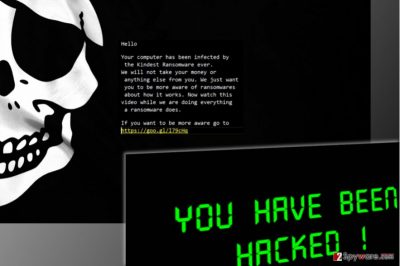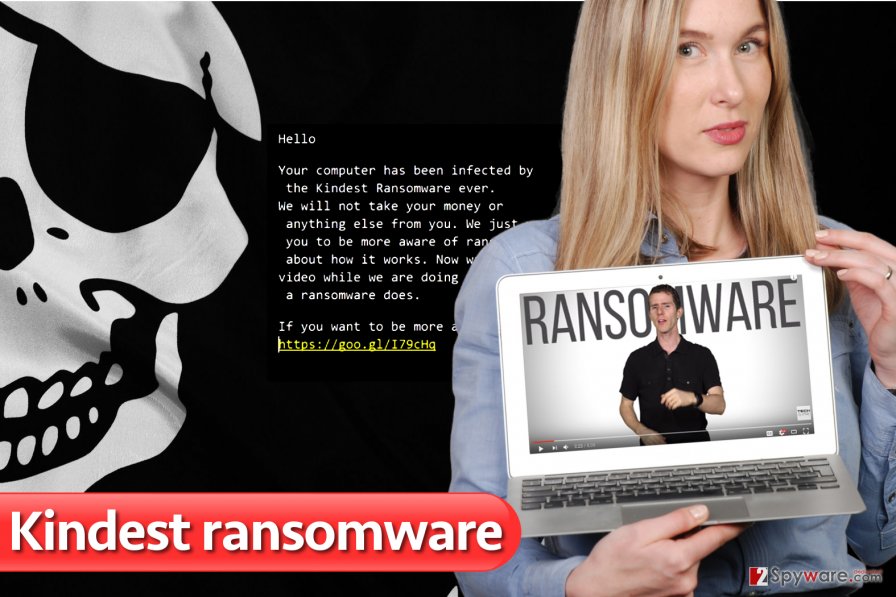Kindest ransomware / virus (Virus Removal Instructions) - Quick Decryption Solution
Kindest virus Removal Guide
What is Kindest ransomware virus?
Kindest ransomware seeks to teach users about data-encrypting viruses
Kindest ransomware virus is actually a name of a malicious program[1] that presents itself as “kindest” one ever. Once installed, it encrypts victim’s files on the computer using encryption algorithm employed by HiddenTear open-source[2] ransomware, and then displays a full-screen message for the victim. The message says that the virus doesn’t ask the victim to pay money in exchange for data decryption key; instead, it wants the user to be more aware of ransomware-type viruses. At this point, the virus suggests watching a Youtube video (the link to the video is provided on the full-screen message). The executive file of this ransomware is called PayUp.exe and it is set to encrypt individual files stored on victim’s PC. The virus likely targets documents, images, videos, audio files, and other relevant records. Once the victim watches the video presented by the virus, virus decrypts all files immediately. However, even if this virus calls itself “educational,” it still belongs to malware category, which means it must be removed without delay. For Kindest virus removal, we suggest performing a system scan with anti-malware software such as FortectIntego.
Kindest virus is based on HiddenTear ransomware, which is a perfect example to prove that open-source or “educational” ransomware[3] is a bad thing. Although the virus was released for educational purposes, many hackers took advantage of free source code of a malicious program. It takes only a few tweaks to convert an educational ransomware into something really dangerous and evil, and Hidden Tear spin-offs[4] such as CerberTear, HappyLocker or HiddenTear 2.0 have already been used as extortion tools against hundreds of computer users. To be sure that your computer is free of any malicious files, remove Kindest malware professionally and do not let its title fool you. If you don’t have a proper computer security software, you can never know what this malicious virus is capable of doing and which version of it infected you.

Methods used to distribute Kindest virus
Kindest ransomware is distributed via spam, the most popular technique to spread these malicious computer programs. Speaking of typical ransomware viruses, fraudsters compose convincing messages and add a matching file to it, for example, they entitle the malicious file as “resume” and send it to thousands of victims asking to take a look at it. They also use similar techniques to spread malware-laden invoices, archives, subpoenas, and other documents[5]. Nowadays, hardly anyone distributes malware in a form of executive (.exe) files. Attackers now employ more advanced techniques and add malicious scripts to Word, PDF, or JS files. Therefore, we recommend users to be extremely careful when opening email messages. If you do not want to infect your computer by opening an email attachment or a link that someone sent you, better double-check who is the sender of every message you receive. If it’s a stranger, stay clear of such email.
Remove Kindest ransomware right away
You should run a system scan with anti-malware program to remove Kindest virus right away. No matter if the ransomware is called nicest or meanest, it is still a ransomware and such programs are highly dangerous. We would like to remind you that this particular ransomware still uses encryption to lock victim’s files, and in case something fails or interrupts its processes, your files can remain encrypted forever. Therefore, a quick Kindest ransomware removal is required. We strongly recommend using anti-malware tools such as FortectIntego because they can thoroughly analyze your PC and provide you with a list of threats that need to be removed.
Getting rid of Kindest virus. Follow these steps
Manual removal using Safe Mode
Uninstall the ransomware according to these guidances.
Important! →
Manual removal guide might be too complicated for regular computer users. It requires advanced IT knowledge to be performed correctly (if vital system files are removed or damaged, it might result in full Windows compromise), and it also might take hours to complete. Therefore, we highly advise using the automatic method provided above instead.
Step 1. Access Safe Mode with Networking
Manual malware removal should be best performed in the Safe Mode environment.
Windows 7 / Vista / XP
- Click Start > Shutdown > Restart > OK.
- When your computer becomes active, start pressing F8 button (if that does not work, try F2, F12, Del, etc. – it all depends on your motherboard model) multiple times until you see the Advanced Boot Options window.
- Select Safe Mode with Networking from the list.

Windows 10 / Windows 8
- Right-click on Start button and select Settings.

- Scroll down to pick Update & Security.

- On the left side of the window, pick Recovery.
- Now scroll down to find Advanced Startup section.
- Click Restart now.

- Select Troubleshoot.

- Go to Advanced options.

- Select Startup Settings.

- Press Restart.
- Now press 5 or click 5) Enable Safe Mode with Networking.

Step 2. Shut down suspicious processes
Windows Task Manager is a useful tool that shows all the processes running in the background. If malware is running a process, you need to shut it down:
- Press Ctrl + Shift + Esc on your keyboard to open Windows Task Manager.
- Click on More details.

- Scroll down to Background processes section, and look for anything suspicious.
- Right-click and select Open file location.

- Go back to the process, right-click and pick End Task.

- Delete the contents of the malicious folder.
Step 3. Check program Startup
- Press Ctrl + Shift + Esc on your keyboard to open Windows Task Manager.
- Go to Startup tab.
- Right-click on the suspicious program and pick Disable.

Step 4. Delete virus files
Malware-related files can be found in various places within your computer. Here are instructions that could help you find them:
- Type in Disk Cleanup in Windows search and press Enter.

- Select the drive you want to clean (C: is your main drive by default and is likely to be the one that has malicious files in).
- Scroll through the Files to delete list and select the following:
Temporary Internet Files
Downloads
Recycle Bin
Temporary files - Pick Clean up system files.

- You can also look for other malicious files hidden in the following folders (type these entries in Windows Search and press Enter):
%AppData%
%LocalAppData%
%ProgramData%
%WinDir%
After you are finished, reboot the PC in normal mode.
Remove Kindest using System Restore
-
Step 1: Reboot your computer to Safe Mode with Command Prompt
Windows 7 / Vista / XP- Click Start → Shutdown → Restart → OK.
- When your computer becomes active, start pressing F8 multiple times until you see the Advanced Boot Options window.
-
Select Command Prompt from the list

Windows 10 / Windows 8- Press the Power button at the Windows login screen. Now press and hold Shift, which is on your keyboard, and click Restart..
- Now select Troubleshoot → Advanced options → Startup Settings and finally press Restart.
-
Once your computer becomes active, select Enable Safe Mode with Command Prompt in Startup Settings window.

-
Step 2: Restore your system files and settings
-
Once the Command Prompt window shows up, enter cd restore and click Enter.

-
Now type rstrui.exe and press Enter again..

-
When a new window shows up, click Next and select your restore point that is prior the infiltration of Kindest. After doing that, click Next.


-
Now click Yes to start system restore.

-
Once the Command Prompt window shows up, enter cd restore and click Enter.
Bonus: Recover your data
Guide which is presented above is supposed to help you remove Kindest from your computer. To recover your encrypted files, we recommend using a detailed guide prepared by 2-spyware.com security experts.If your files are encrypted by Kindest, you can use several methods to restore them:
If you can’t open your files…
Data Recovery Pro can help you to recover files lost after Kindest ransomware attack. Here’s how to use this software:
- Download Data Recovery Pro;
- Follow the steps of Data Recovery Setup and install the program on your computer;
- Launch it and scan your computer for files encrypted by Kindest ransomware;
- Restore them.
ShadowExplorer trick
ShadowExplorer software can help you to restore files from their Volume Shadow Copies. If your files were encrypted and the virus did not automatically decrypt them, follow these steps:
- Download Shadow Explorer (http://shadowexplorer.com/);
- Follow a Shadow Explorer Setup Wizard and install this application on your computer;
- Launch the program and go through the drop down menu on the top left corner to select the disk of your encrypted data. Check what folders are there;
- Right-click on the folder you want to restore and select “Export”. You can also select where you want it to be stored.
Finally, you should always think about the protection of crypto-ransomwares. In order to protect your computer from Kindest and other ransomwares, use a reputable anti-spyware, such as FortectIntego, SpyHunter 5Combo Cleaner or Malwarebytes
How to prevent from getting ransomware
Do not let government spy on you
The government has many issues in regards to tracking users' data and spying on citizens, so you should take this into consideration and learn more about shady information gathering practices. Avoid any unwanted government tracking or spying by going totally anonymous on the internet.
You can choose a different location when you go online and access any material you want without particular content restrictions. You can easily enjoy internet connection without any risks of being hacked by using Private Internet Access VPN.
Control the information that can be accessed by government any other unwanted party and surf online without being spied on. Even if you are not involved in illegal activities or trust your selection of services, platforms, be suspicious for your own security and take precautionary measures by using the VPN service.
Backup files for the later use, in case of the malware attack
Computer users can suffer from data losses due to cyber infections or their own faulty doings. Ransomware can encrypt and hold files hostage, while unforeseen power cuts might cause a loss of important documents. If you have proper up-to-date backups, you can easily recover after such an incident and get back to work. It is also equally important to update backups on a regular basis so that the newest information remains intact – you can set this process to be performed automatically.
When you have the previous version of every important document or project you can avoid frustration and breakdowns. It comes in handy when malware strikes out of nowhere. Use Data Recovery Pro for the data restoration process.
- ^ Malicious programs. Securelist. Information about Viruses, Hackers and Spam.
- ^ Ransomware Recap: Threats from Open Source Code on the Rise. Trend Micro USA. Security News.
- ^ Karsten Hahn, Tilman Frosch. It's Educational - On the No 1 Argument for Open Source Ransomware. G DATA Software AG. Security Blog.
- ^ Jornt van der Wiel. Hidden tear and its spin offs. Securelist. Information about Viruses, Hackers and Spam.
- ^ Olivia Morelli. How to identify an email infected with a virus?. 2-Spyware. Fighting Against Spyware & Malware.





















